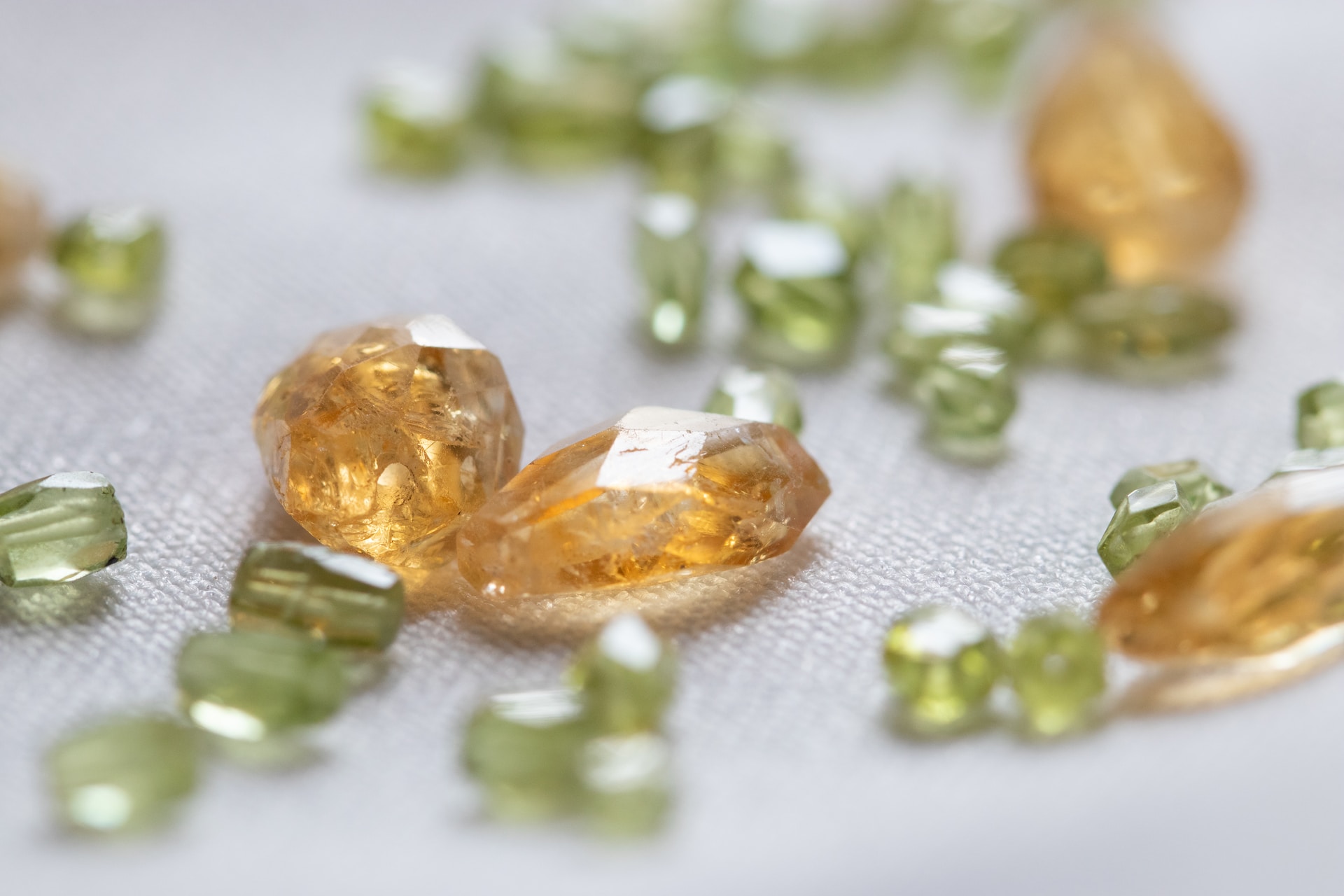Style • 06/03/2023
What Is My Birthstone and What Does It Mean?

Revivalist is a reader-supported endeavor and our posts may contain affiliate links. When you buy through links on our site, we may earn an affiliate commission.
Markers like your birth month, zodiac sign and birthstone anchor you in a particular place in time, help you connect with others and become part of your identity. Almost everyone knows their birth mong, and even if you don’t believe in astrology, you probably know your zodiac sign. Far fewer people know their designated gem.
What is your birthstone? Do you know what it is and the symbolism it carries? Learn your special gem so you can wear it with pride. Who knows — maybe it will unlock some hidden potential in you. At least now you’ll know what to ask for your next birthday.
History of Birthstones
You can trace the use of symbolic gemstones back to the time of Moses in the Bible. God gave instructions for the high priest’s breastplate to contain 12 precious stones, one symbolizing each of the tribes of Israel. While the gems of today’s birthstone system differ from those used long ago, people have been associating meaning with precious stones ever since.
Over time, the birthstones and meanings have changed. Our “modern” system began in 1912 when the Jewelers of America decided on an official monthly gem. It has undergone many changes over the years. Most recently, opaque gemstones on the list were swapped for transparent alternatives.
What Is Your Birthstone?
Here you’ll find each month listed with its corresponding birthstone. Some have multiple options, especially if the original stone was opaque.
January — Garnet
Garnet brings a fire to cold January babies. Its traditional red coloring is striking in any setting. You can also find this stunner in shades of orange, yellow, green and blue. It has a high hardness rating, so it works well for the jewelry you wear daily. You won’t have to worry about it scratching or chipping.
Garnet has symbolized many different meanings across the years. It protects against injury and was a favorite of travelers and sailors — many old Viking jewelry contained this vibrant gem. It’s also connected to happiness and friendship, making them a perfect gift for your bestie.
February — Amethyst
While you may think amethyst is a distinct gem, it’s actually a classification of purple quartz. You can find it in shades from the palest lilac to deep purples. It has a high hardness level, so it works well for everyday wear.
Amethyst is steeped in history. It’s been a long-time favorite of the nobility because its purple color is a symbol of royalty. In Ancient Greece, it was associated with Bacchus, the god of wine. The legend was that amethyst could keep your head clear from the effects of strong drink. Today, it stands for mental clarity, peace and inner strength.
March — Aquamarine or Bloodstone
March is the first month with two possible birthstones. Aquamarine is the modern choice since it’s transparent. This blue to blue-green gem aptly gets its name from the Latin words meaning seawater. As such, sailors often wore or carried it to protect them against unfriendly waters. Aquamarine has come to symbolize happy marriages, peace and an even temper. It has a high hardness, so it’s a good choice for everyday jewelry.
The opaque alternative for March is bloodstone, which consists of deep green jasper flecked with iron ore, making it appear spotted with blood. In ancient times healers thought it would cure blood diseases and bring health to the wearer. Today, some wearers hope it will clear away negative energy. Bloodstone also has a high hardness, so you can use it in any jewelry setting without fear of damage.
April — Diamond
Diamond is the most easily recognized gem across the world. Most people seek out the colorless variety, although you can find it in a full spectrum of colors. Diamond is the hardest known substance, able to cut through almost anything. That strength gives makes it the perfect symbol for love and lasting relationships. Its high clarity also stands for purity and innocence.
While you may consider diamonds solely as engagement or wedding ring gems, you can gift yourself one of these beauties anytime. There’s no need to wait on a romantic partner to get the idea in their head.
May — Emerald
This deep green gem is easily recognizable since its color remains fairly consistent. Emeralds are prone to imperfections, which dictate their market value. Its hardness level is quite high. However, the abundance of inclusions can drastically weaken a gem making it easily breakable. You’ll need to care more for emeralds than some of your other jewelry pieces.
In many ancient Eastern cultures, emeralds symbolized fertility and rebirth. Others used it as a talisman of healing or to bring good fortune. It was said to be a favorite of Queen Cleopatra. Today, it’s a sign of healing and success.
June — Alexandrite, Pearl or Moonstone
Alexandrite is the modern choice for June babies. Its chameleon coloring makes it unique among the other birthstones. It looks green in sunlight or under fluorescents, but it turns a deep red under incandescent lighting. Alexandrite was named for Czar Alexander II, who favored it. They are rare and expensive, so most jewelers stock still-costly synthetic versions. This stone is associated with intelligence and good luck.
Pearl is the cheaper opaque alternative. Its claim to fame is the only stone originating from a living creature. It’s usually a shade of white but can come in other colors, primarily if grown in a lab or farm. Pearls are becoming rare in the wild, so most are now synthetically cultured. Historically and into the present, they represent purity and innocence.
Moonstones are almost opalescent, though they don’t reflect a full rainbow. They seem to glow from within and are typically white with a blue sheen. It’s a sacred stone in India and is thought to hold a spirit that can bring you good fortune. Elsewhere it symbolizes love and fertility.
July — Ruby
Rubies are vivid red gems in the same family as sapphires. They’re the second strongest gem after diamond. Because of their strength, warriors across the ages would wear them to increase their physical prowess and protect them from harm.
A ruby’s coloring is the most significant determinant of its value. True medium to deep red stones fetch the highest prices. Those with orange or purple undertones are less valuable but more accessible to the general public. Rubies stand for health, wealth and love. Their color and symbolism make them a perfect gift for a romantic partner.
August — Peridot or Sardonyx
Peridot is a lively green color ranging from brownish green to lime to deep hues. Its richest colorings are sometimes confused with emerald, but peridot has a yellowish undertone making it unique. Since ancient times many cultures have believed its vibrant appearance, reminiscent of the sun’s power, could protect them from evil spirits at night. Legend in Hawaii says the stones are tears from the goddess Pele. Now they’re a symbol of prosperity and wealth. Peridot has a moderate hardness that can be scratched easily, so wear it carefully.
Sardonyx is the opaque August alternative and is richly steeped in history. Greek and Roman warriors would carry sardonyx into battle, etched with the figures of heroes like Hercules or gods like Mars to protect them and give them strength and victory. The stone has bands of rust color and white. Today, it represents courage and happiness.
September — Sapphire
Sapphires are in the same family as rubies — corundum. These stones are rubies when red but sapphires when present in any other color. However, blue is the most popular choice for this gem. It has a high hardness and is excellent for everyday wear.
These stones were thought to be a shield against harm for the wearer. In the Middle Ages, priests began the association between sapphires and heaven. They wore it as a symbol of spirituality. Royalty wore it in hopes of receiving heavenly blessings. In modern times, it’s a representation of wisdom and faith.
October — Tourmaline or Opal
Tourmaline is a unique stone found in many colors and even multi-colors in a single gem. The most sought-after variant is the watermelon tourmaline with bands of pink, white and green. However, the pink variety is the rarest in nature and yet the most common depiction of October’s birthstone. Tourmaline is a modern gem symbolizing healing and creativity. It’s also thought to promote digestion and boost the wearer’s immune system.
October babies can also choose from opals, which are so unique they need their own vocabulary. Their base color is white or black, with a play of colors covering the entire spectrum. Opals are incredibly delicate, so you must wear them with caution and take good care of them. They’re thought to represent light, magic and healing. Some ancient wearers even thought they could make you invisible. While many cultures find these stones lucky, some associate opals with bad luck and misfortune.
November — Citrine or Topaz
Unlike most months, November’s birthstone options are both transparent and of a similar color. Citrine is a golden gem ranging from pale yellow to an orangey-brown hue. It’s part of the quartz family and typically starts as amethyst but is heated to bring out the yellow tones. It’s a very affordable and strong stone for all jewelry pieces. It represents healing and happiness.
Topaz comes in many colors, but blue and yellow are the most popular. Its yellow variation is most commonly associated with November’s birthstone. Until modern science discovered methods of differentiating gems, people thought all golden stones were topaz. Wearing a topaz is a symbol of love and wealth.
December — Tanzanite, Blue Topaz, Blue Zircon or Turquoise
If you have a December birthday, you’re in luck as long as you love blue. You have four different options for your beautiful blue jewelry. Modern birthstone lists include tanzanite, blue topaz and blue zircon for this month.
Tanzanite is found only in a specific location in Tanzania. It was once a cheaper alternative to sapphire but has gained popularity on its own. It is a rich blue-violet color and represents perception and purity. Blue topaz is golden topaz heated to reveal a medium aqua color. It symbolizes wealth and success. Finally, blue zircon gives December babies a pale blue option. It’s been a popular option since ancient times and symbolizes spirituality and peace.
The opaque alternative for this month is turquoise. This blue-green stone has been a popular option for centuries, dating back to ancient Egypt. It can present as one solid color or have a matrix of brownish veins running through it. Turquoise is said to bring good health and fortune.
You Can Try More Than One
Unlike your birth month, which is set in stone — pun intended — you can play around with gems outside your assigned one. Select something you feel strongly about. What colors do you love? Do you connect with the symbolism of a different birthstone? Go with your gut. These lovely gems are expensive, so you want something to make your heart sing rather than blindly following tradition.
Subscribe to Our Weekly Newsletter
We would love to connect deeper with you!


